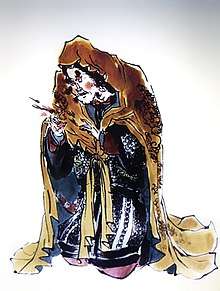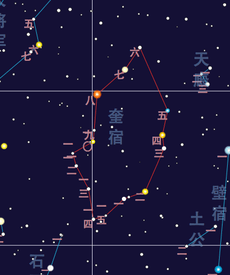Kui Mulang
Kui Mulang (Chinese: 奎木狼; lit.: 'The Wood Wolf of Legs') is a star deity and one of the 28 Mansions in Chinese traditional religion.[1][2] Kui Mulang originated from the ancient people's worship of the ancient stars and was a product of the combination of ancient Chinese mythology and astronomy. He appears in some works including Journey to the West and Fengshen Yanyi.[3]
| Kui Mulang | |||||||
|---|---|---|---|---|---|---|---|
 The painting picture of Kui Mulang | |||||||
| Traditional Chinese | 奎木狼 | ||||||
| Simplified Chinese | 奎木狼 | ||||||
| Literal meaning | The Wood Wolf of Legs | ||||||
| |||||||
Star location

Among the twelve constellations, Kui Xiu is the four-legged fish palace of Heshansu (和善宿), and this constellation is Andromeda. Andromeda is a constellation that appears in the sky in the middle of November. It has a spiral nebula, which is a small universe about two and a half million light-years away from Earth. It is shaped like a fish, India calls it a fish palace, and China calls it Kui Xiu. This constellation is the West, the White Tiger fifty-four constellation, the head of more than seven hundred stars, is the tail of the White Tiger constellation.[4]
Mythological records
According to the Investiture of the Gods (Fengshen Yanyi), Kui Mulang may be related to Li Xiong who was deified after he died in the Battle of the Ten Thousand Immortals. Kui Mulang is also linked to a historical figure called Ma Wu, a general who hailed from the town of Huyang in Tanghe, located in the Henan province.[5]
Journey to the West
In the classic Chinese novel Journey to the West, Kui Mulang appears as a demon Yellow Robe. The Yellow Robe Demon (黃袍怪) is based in Moon Waves Cave (波月洞) on Bowl Mountain (碗子山) in the Kingdom of Baoxiang (寶象國). He once fell in love with a Jade Maiden (玉女) in Heaven and decided to elope with her. He became a demon lord while the Maiden was reincarnated into the human world as Baihuaxiu (百花羞), the third princess of the Kingdom of Baoxiang. The demon kidnaps the princess (though she has no memory of her existence as a Jade Maiden), marries her for 13 years, and has two children with her.[3][6][7]
Upon learning that Tang Sanzang had arrived to his mountain, knowing that eating the monk's flesh would grant him immortality or long lifespan, the Yellow Robe Demon captured Tang Sanzang. Zhu Bajie and Sha Wujing try to save their master but are no match for the demon. Zhu Bajie goes to bring back Sun Wukong – who was previously banished by Tang Sanzang after killing the White Bone Demon – to help them. Sun Wukong manages to defeat the demon, which mysteriously vanishes after his defeat. Wukong then seeks help from Heaven to track down the demon and learn his true identity. He is later revealed to be a guise assumed by Revatī, the Wood Wolf of Legs (奎木狼), a star deity in the heavenly court, and one of the 28 Mansions. The 28 Mansions are part of the Chinese constellations system. They can be considered as the equivalent to Western astrology. The Jade Emperor discovers that one of the 28 Mansions is missing, so he orders the remaining 27 to subdue the demon. The Wood Wolf is then subdued and brought back to Heaven. As punishment, he is ordered to become a furnace keeper under Taishang Laojun.[3][8]
References
- 最强天庭系统 (The strongest heavenly system) (in Chinese). renshenchujiu.
- "奎木狼、黄袍怪为何比牛郎织女幸福?". 知乎专栏 (in Chinese). 29 August 2017.
- "难怪奎木狼装不认识孙悟空,原来怕悟空知道他与玉帝之间的秘密?_玉女". Sohu (in Chinese). 17 September 2018.
- "15,奎宿 (奎木狼) - 初恋星座网". www.chulian.cn.
- Yap, Joey (2015). Qi Men Dun Jia: 28 Constellations. Joey Yap Research Group. ISBN 978-967-0794-54-9.
- "百花羞为什么不认奎木狼?原因是什么". Qulishi (in Chinese). 5 April 2019.
- "西游黄袍怪:前世相恋,今生相怨". 豆瓣 (in Chinese). 20 March 2018.
- 中文經典100句: 西遊記 (in Chinese). 商周出版. 2008. ISBN 978-986-6571-26-8.